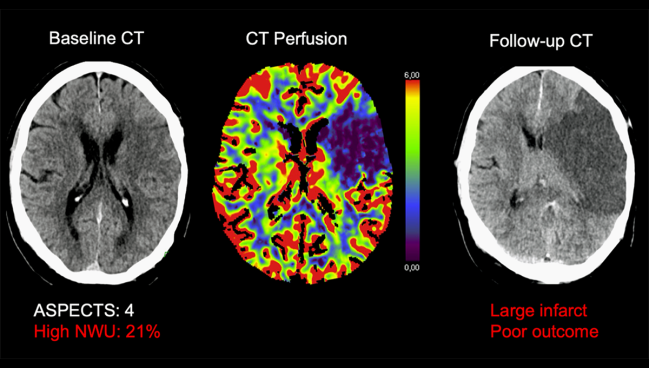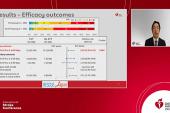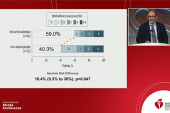Stroke Thrombectomy May Work for Large Infarcts in the Late Time Window
The retrospective data raise hopes that ongoing randomized trials will prove a benefit in this subset of patients with acute stroke.

Photo Credit: Gabriel Broocks
Even patients with acute ischemic stroke who are delayed in getting to the hospital and already have large cerebral infarcts may derive a benefit from endovascular therapy to remove the clot, retrospective data from a German registry suggest.
Among patients who were treated more than 6 hours after stroke onset and who had extensive signs of infarction on CT (ASPECTS 5 or less), those who had good recanalization following stroke thrombectomy were more likely to have a favorable functional outcome—defined as a modified Rankin Scale (mRS) score of 0-3—at 90 days than were those whose vessel was not opened sufficiently (32% vs 13%).
Other outcomes, including functional independence (mRS score 0-2) at 90 days and early neurological improvement, seemed to be helped by the procedure as well, researchers led by Gabriel Broocks, MD (University Medical Center Hamburg-Eppendorf, Hamburg, Germany), report in a paper published online recently in JAMA Network Open.
The study highlights a new segment of acute ischemic stroke patients who could benefit from endovascular therapy if the results are confirmed in ongoing trials. Though prior trials have established the safety and efficacy of mechanical thrombectomy both within 6 hours of symptom onset and up to 24 hours after stroke onset, with selection based on imaging, they have mostly excluded patients with large cerebral infarcts at baseline.
RESCUE-Japan LIMIT, reported earlier this year, showed that endovascular therapy improved functional outcomes in patients with large ischemic cores (ASPECTS 3-5), although most of the patients were enrolled within 6 hours of stroke onset.
Thus, there remains uncertainty about patients who both present late and have large infarcts, a group included in several trials that are enrolling or have recently completed enrollment, including TENSION, TESLA, SELECT2, and ANGEL-ASPECT.
In that context, Broocks told TCTMD, these retrospective data, which are limited by potential selection bias and the lack of a control group of patients who didn’t undergo thrombectomy, “are very encouraging for the currently running trials.”
Indeed, commented Ashutosh Jadhav, MD, PhD (Barrow Neurological Institute, Phoenix, AZ), the release of this paper was well timed. Though the study has the usual limitations of a registry analysis, he said, “I think it’s promising and it certainly lends confidence that the ongoing trials or completed trials will show benefit. And so it’s kind of a bridge until we get to the results of the randomized controlled trial data.”
German Stroke Registry-Endovascular Treatment
For the study, Broocks et al turned to the German Stroke Registry-Endovascular Treatment, which includes information collected from 25 stroke centers across Germany. The current analysis focused on 285 patients (median age 73 years; 51% men) who underwent mechanical thrombectomy between July 2015 and December 2019, had a large cerebral infarct (ASPECTS of 5 or less), and presented from 6 to 24 hours after stroke onset.
Successful recanalization, defined as a modified TICI score 2b or 3, was achieved in 75% of patients. This was associated with significantly greater odds of the following outcomes:
- Favorable functional outcome at 90 days (adjusted OR 4.39; 95% CI 1.79-10.72)
- Functional independence at 90 days (adjusted OR 7.24; 95% CI 2.01-26.09)
- Early neurological improvement (adjusted OR 2.49; 95% CI 1.15-5.37)
Inverse-probability-weighting analyses indicated that successful recanalization was associated with relative increases in the probabilities of a favorable outcome (by 19%), functional independence (by 16%), and early neurological improvement (by 14%).
Further analysis suggested that recanalization improves outcomes at time windows up to 17.6 hours after stroke onset and for patients with ASPECTS of 3-5.
The rate of secondary symptomatic intracerebral hemorrhage overall was relatively low at 6.3%, indicating that “endovascular treatment for these specific patients may be safe,” Broocks said.
Defining the Boundaries of Endovascular Therapy
It’s known that opening vessels in patients with large-vessel occlusions is good in a general sense, and now researchers are aiming to define situations for which there is or is not a benefit of endovascular therapy, Jadhav said.
There patient groups of particular interest are those with an NIHSS score < 6, those with more-distal occlusions, and those with large ischemic cores. The field is closest to answering whether intervention is beneficial in that last group of patients and whether the general ASPECTS cutoff for eligibility should be as low as 3, Jadhav said, noting that ANGEL-ASPECT in China and TESLA in North America recently completed enrollment.
Some of these patients with large infarcts are already being treated in an off-label fashion, with much variation across centers and regions, he observed. “That is why we’re doing the trials, to harmonize practice patterns and have higher-quality data to justify one approach or the other.”
It certainly lends confidence that the ongoing trials or completed trials will show benefit. Ashutosh Jadhav
Some physicians may be justifying intervention in these patients based on hints of benefit in certain studies and knowledge of the poor outcomes and complications associated with no treatment, Jadhav added. “I think that if people are currently doing this off-label it’s because we know the alternative in these patients. When you don’t open up the blood vessel, it can be pretty devastating.”
If the ongoing trials demonstrate the safety and efficacy of thrombectomy in patients presenting late and/or with large infarcts, “the implications are going to be pretty significant because we’re going to see an increase in procedures performed,” according to Jadhav.
He pointed to an abstract he and colleagues presented in February at the International Stroke Conference 2022 estimating that 18,484 adults met strict eligibility criteria for endovascular therapy in 2021, and that an additional 9,621 with unfavorable imaging (large ischemic core) could become eligible each year if ongoing trials show a benefit. And in another study from his group, published in Stroke in 2018, about 25% of patients who didn’t meet criteria for thrombectomy in the late time window were excluded due to unfavorable imaging.
Moving forward, Broocks said, it will be important to further refine patient selection within the subset with large infarcts to identify those who will most benefit and also to determine whether there is a difference when selecting patients based on CT versus MRI.
Todd Neale is the Associate News Editor for TCTMD and a Senior Medical Journalist. He got his start in journalism at …
Read Full BioSources
Broocks G, Hanning U, Bechstein M, et al. Association of thrombectomy with functional outcome for patients with ischemic stroke who presented in the extended time window with extensive signs of infarction. JAMA Netw Open. 2022;e2235733.
Disclosures
- Broocks reports receiving compensation as a speaker from Balt and personal fees from Eppdata GmbH outside the submitted work.
- Jadhav reports no relevant conflicts of interest.





Comments